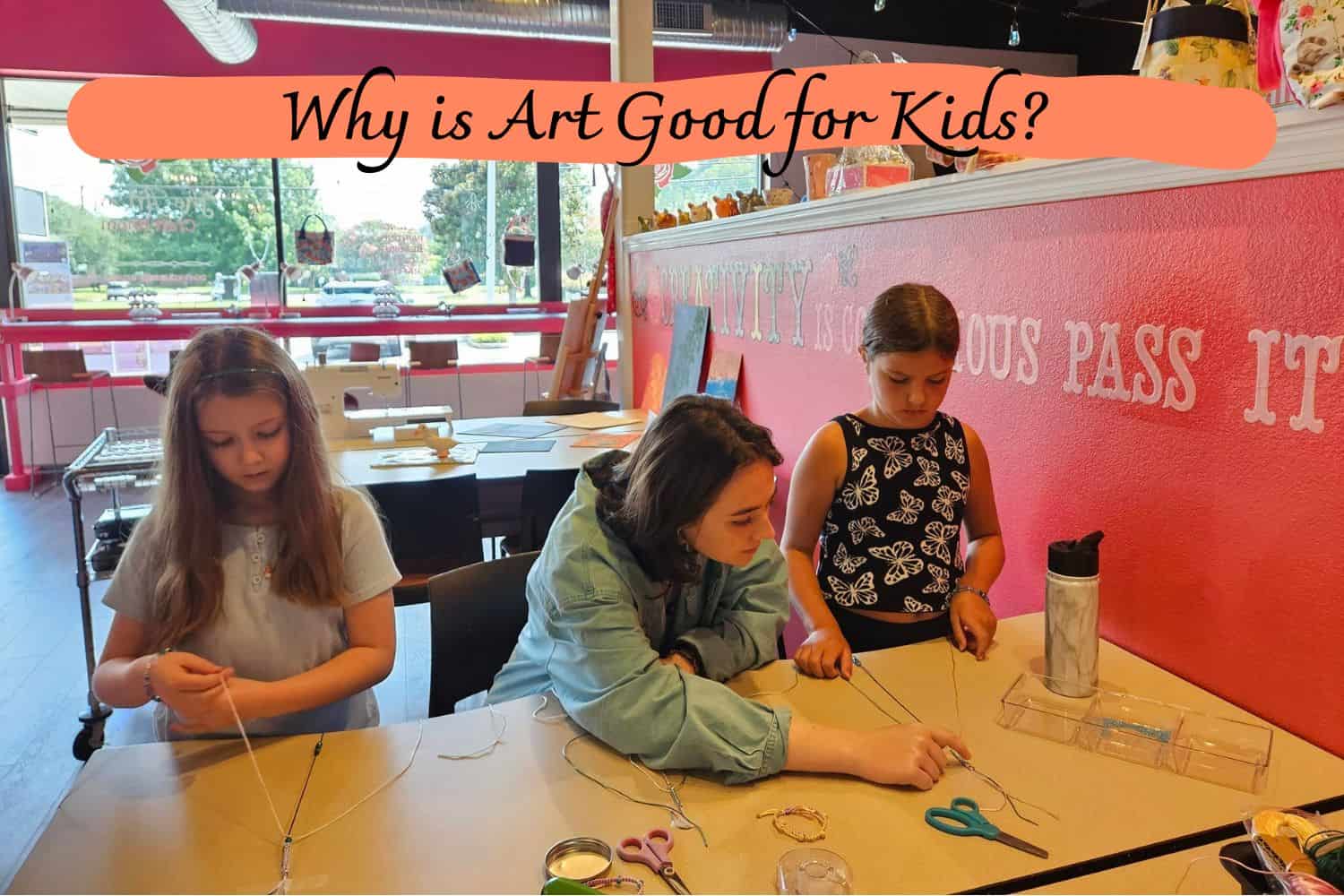Get to know why is art good for kids and explore the major advantages that come with embracing their creative expression.
Why is Art Good for Kids? | Uncovering Benefits

Are you looking for ways to help your child tap into their creative potential? Or perhaps you’re wondering if art is worth the investment of time and money.
With a growing body of research demonstrating that involvement in the arts has profound beneficial effects, it’s increasingly evident that discovering art provides key emotional and mental benefits for children.
Why is Art Good for Kids?
Discover the multitude of advantages arts bring to children’s development. Nurture problem-solving abilities, unleash creativity, foster literacy, enhance fine and gross motor skills, promote connection, and deepen understanding.
In this blog post, we’ll explore why art is so important for kids, what types of activities can be enjoyed by budding artists, as well as highlighting some inspiring stories from parents whose kids have flourished through participation in the arts.
Get ready to learn more about how artistic exploration could make a positive impact on your child’s development!
Reason Why is Art Good for Kids
Enhance Motor Skills
Developing motor skills is essential for children, but it doesn’t have to feel like a chore. Engaging in art activities can be both enjoyable and beneficial for their development. By gripping a paintbrush, drawing dots and lines, mixing colors, cutting with scissors, and engaging in other arts and crafts tasks, children can steadily improve their dexterity and coordination.
Arts and crafts play a significant role in enhancing both gross motor skills (larger movements) and fine motor skills (smaller movements). Additionally, they promote hand-eye coordination, which is crucial for various daily activities. Activities like drawing, painting, and crafts encourage the formation of neural connections, while exercises such as using scissors, finger painting, and origami focus on fine motor skills.
The benefits of art activities extend beyond physical development. They also contribute to cognitive and emotional growth. Drawing and painting allow the eyes to guide the hands, honing hand-eye coordination. From simple tasks like coloring within the lines to intricate projects like murals and pottery, every creative endeavor provides an opportunity for skill improvement.
To ensure that children are on track with their motor skills development, the National Institutes of Health suggests specific milestones. Around age three, they should be able to draw a circle and begin using safety scissors. By the age of four, they may progress to drawing a square and cutting straight lines. Recognizing the importance of dexterity for future tasks like writing, many preschool programs prioritize scissor activities.
Through art and crafts, children can have fun while sharpening their motor skills. It’s a win-win situation that fosters creativity and prepares them for future challenges.
Enhancing Language Development
Discover the power of art in developing children’s language skills. By engaging in artistic activities, children are prompted to express themselves, discuss their creations, and explore concepts such as colors and shapes, thereby enhancing their communication and vocabulary abilities. Moreover, art enables children to gain a deeper understanding of the world around them as they navigate instructions and problem-solving tasks, fostering their comprehension skills.
Take the fun a notch higher with games like Pictionary, which captivates children of all ages by using pictures to depict words. What’s more, art significantly contributes to literacy by refining reading, writing, speaking, and listening skills. Encourage your child to match illustrations to sentences or parts of a story, unlocking their reading potential. Furthermore, inspire them to unleash their creativity through music, dance, or drama, providing a well-rounded language development experience.
Enhance Children’s Cognitive Development
Art and crafts have a profound impact on the development of children’s brains. Through artistic choices, children enhance their problem-solving and critical thinking skills, which have far-reaching benefits in various aspects of life. Moreover, exposure to art nurtures children’s visual learning abilities, allowing them to interpret, process, and analyze what they see, empowering them with transferable skills.
Furthermore, engaging in art fuels children’s creativity and craftsmanship, fostering originality and imagination from an early age. By expressing themselves artistically, children discover their preferred art medium, leading to a deeper sense of self-discovery. Additionally, art instills in children the invaluable qualities of focus and concentration as they commit their efforts to completing projects, especially those that are intriguing or unfamiliar to them.
Unlock Life and Social Skills
Navigating life’s challenges requires essential skills, especially for children. That’s why empowering them with the tools to thrive is crucial. Art, surprisingly, offers a powerful platform for fostering these vital life and social skills. By facilitating a shared experience with peers and adults, art encourages teamwork and cooperation. Collaborative projects help children understand accountability, while art activities instill the importance of following instructions.
Moreover, art equips kids with the ability to accept constructive criticism gracefully and embrace diverse perspectives. Additionally, it empowers children, particularly those facing adversity, to enhance their behavior and outlook on life. Beyond skill development, art classes provide an ideal environment for children to forge lasting friendships.
Promoting Cultural Understanding
Broaden your children’s horizons and foster a sense of inclusivity through the captivating world of art and crafts. By delving into various cultures and their rich traditions, kids gain a profound appreciation for diversity and realize that we are all equal, regardless of our beliefs.
This newfound understanding is an invaluable tool in combating bullying. By engaging in traditional art forms, let us embark on a journey to explore the origins and significance of these creations, allowing our children to embrace and accept the uniqueness of others.
Promoting Confidence and Self-Expression
Enhancing a child’s confidence is a powerful way to set them up for success. Discovering their strengths and encouraging them to take calculated risks can have a lasting impact. Art offers a unique opportunity for students to develop perseverance and patience, as they are taught to never give up and continuously improve their artistic skills.
Moreover, it fosters emotional intelligence and self-expression, enabling children to process and express their emotions in healthy ways. The art experience also provides a peaceful and reflective environment, allowing for valuable introspection.
Enhance Emotional Wellbeing
Discover the remarkable impact that art can have on children’s emotional well-being. Engaging in arts and crafts activities can provide a vital sense of purpose, particularly for those facing challenges with learning or social skills. Additionally, art offers a unique opportunity for children to connect with peers and strengthen familial bonds.
But did you know that art can do even more? It can effectively reduce anxiety, depression, and stress levels, creating a lasting sense of calm and happiness. Taking the time to immerse oneself in the creative process is an ideal way for both children and adults to unwind and find solace.
Moreover, fostering creativity in early childhood can unlock a world of possibilities. By encouraging your child’s artistic development, you may ignite a lifelong passion that could translate into a fulfilling hobby or even a thriving profession.
Invest in the emotional well-being of your child through the transformative power of art. Embrace the joy of painting, drawing, and other artistic endeavors as a family, and watch as their world blossoms with creativity and contentment.
Spend Meaningful Moments with Your Kids
Nurture your relationship with your children by engaging in arts and crafts together. This activity allows for quality bonding time while creating lasting memories. As you work side by side, you can share in conversations about your creations and explore other ideas and topics. It’s an opportunity to express your thoughts, emotions, and worries. What’s more, you can delight in the fact that your child is taking a break from technology and screens for a while.
Conclusion
Art is something that not only is beneficial to something like child development but also something that can bring joy to children, adults, and everyone in between. Art allows for self-expression and play for kids which are important in both physical and cognitive growth.
And while the tangible benefits of learning art are impressive, it’s important to note that simply engaging with art can help children become coming more creative and critical thinkers.
Art helps foster creativity, imagination, perseverance, communication skills, and much more. It isn’t just a way for them to interact with the world around them in meaningful ways – it’s an avenue of exploration as well. Creating and viewing art can be great fun and a very positive experience in a child’s life!
So encourage your children to take opportunities to explore their artistic side – who knows where it will lead them – whether it’s into podcasting or painting or mural work – the possibilities within the arts are truly limitless!
Thanks for reading our article on why is art good for kids. If you want to know more information, visit our website here.
Read more:
8 Benefits of Art for Children + How to Teach It
